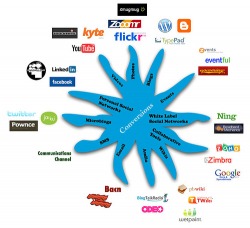The Course: "Information Design 303 - The Web 2.0"
General Overview of the Course:
IFD 303 is a hands-on Web 2.0 theory and production course that focuses on creating branding identities for students (also known as “platform building”) using the social media aspects of Internet communication.
The class also explores the implications of digital media, social media, the Internet, and other electronic communication (e.g., cellphones, MP3 players) in our lives, our thinking, and our habits.
Students will explore the history, structure, function, and social impact of the Internet, especially Web 2.0 and social media, as well as digital media and other electronic communication tools.
Students will also learn about branding, marketing, and platform building using these various Web 2.0 and Internet tools.
In the process, students will also:
The class also explores the implications of digital media, social media, the Internet, and other electronic communication (e.g., cellphones, MP3 players) in our lives, our thinking, and our habits.
Students will explore the history, structure, function, and social impact of the Internet, especially Web 2.0 and social media, as well as digital media and other electronic communication tools.
Students will also learn about branding, marketing, and platform building using these various Web 2.0 and Internet tools.
In the process, students will also:
- critique Web sites,
- learn about social media,
- explore production procedures and techniques,
- construct their own Web sites,
- integrate media into their Web sites and social media sites, and
- produce Internet-based content in a variety of Web 2.0 formats including blogging (e.g., Blogger and Wordpress), microblogging (e.g., Twitter), social networking (e.g., Facebook, LinkedIN), photo-sharing (e.g., Flickr, Shutterfly, Photobucket), video sharing (e.g., YouTube, Vimeo, Blip.TV), and podcasting (e.g., iTunes).

Social media involves various ways to have conversations using Web 2.0 tools.
Learning Objectives of the Course:
- to understand the Internet and its history, basic structure, and functions, as well as its cultural, political, economic, informational, and military contexts;
- to appreciate the social impact of the Internet as a medium of communication;
- to evaluate and critique sites and information on the World Wide Web (WWW);
- to construct information design and information architecture flowcharts of Web site navigation and layout for personal and professional branding;
- to construct Web pages using online drag-and-drop site utilities (such as Wix.com, Weebly.com, Network Solutions, etc.);
- to create, manipulate, and integrate multimedia assets for Web sites and social media sites;
- to produce Web-based content individually and in a workgroup;
- to understand and use social media, focusing on the current “big four”: Facebook, Twitter, YouTube, and Flickr; and
- to begin to explore and understand some of the nearly unfathomable changes that are taking place in humans and human society as a result of mass digital media communication tools.
